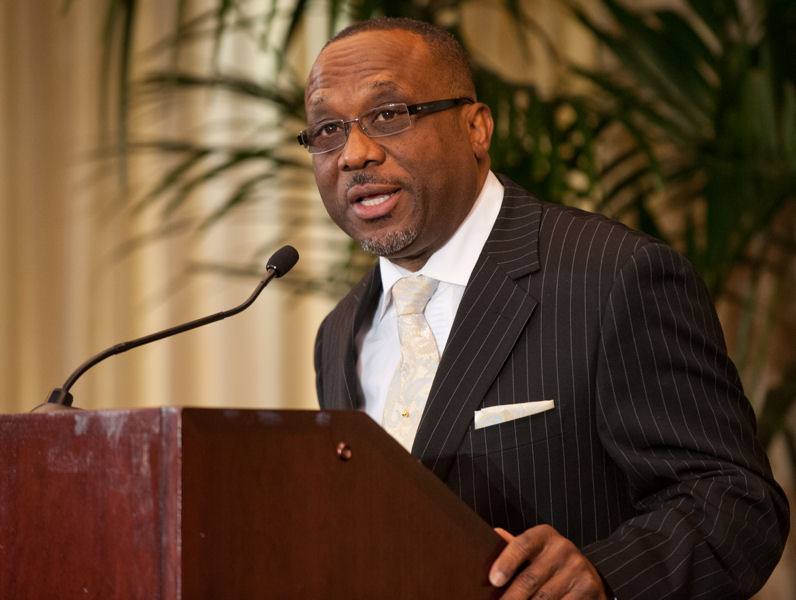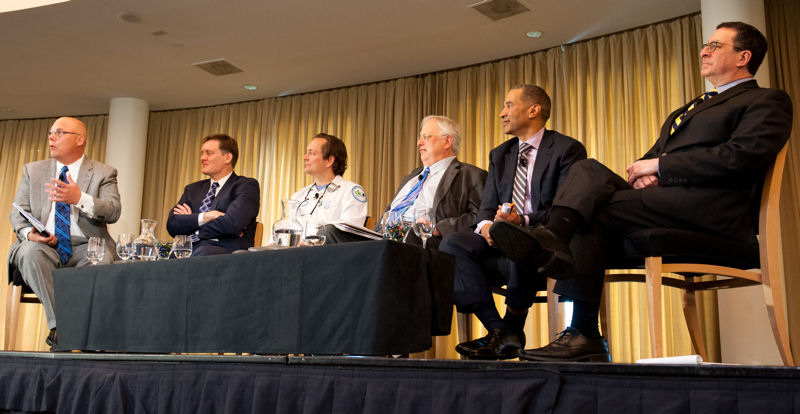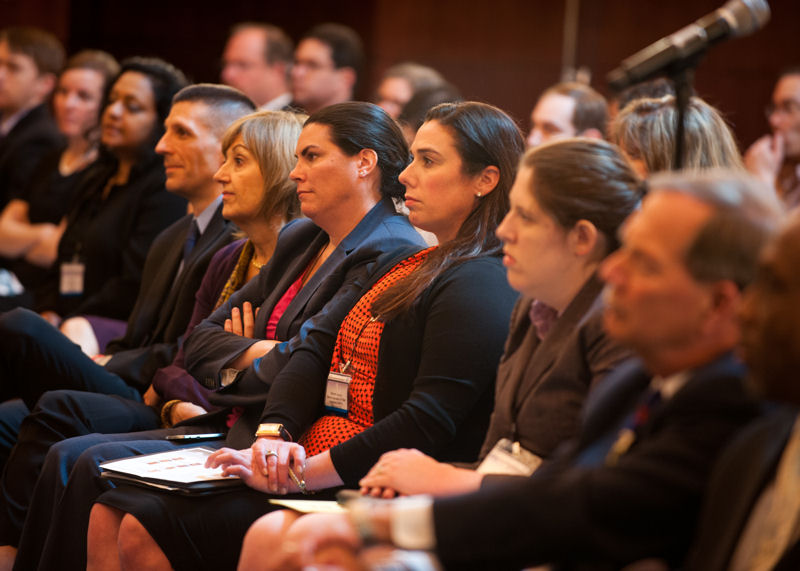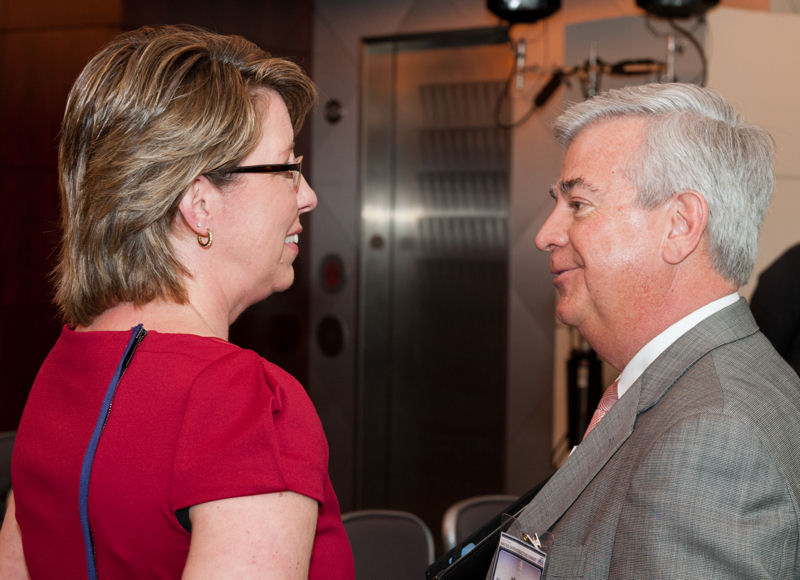Water industry leaders spoke passionately about water and the need for water infrastructure funding during the National Water Infrastructure Summit, held April 16 in Washington, D.C. A unified message of expanding innovation, increasing cooperation across the water sector, and garnering support from the public and government was presented to 140 attendees.

Water Environment Federation (WEF; Alexandria, Va.) President Cordell Samuels described water infrastructure as the “lifeblood of our economy” during his opening remarks at the summit. Photo courtesy of Allison O’Brien.
“Water infrastructure is the lifeblood of our economy,” said Water Environment Federation (WEF; Alexandria, Va.) President Cordell Samuels. “We must have reliable and resilient water infrastructure systems to attract and retain industry, business, and qualified workers,” he said.
The event, organized by WEF and national Water for Jobs campaign partners, raised awareness about the need for reliable and resilient water infrastructure and how it creates jobs, drives innovation, and protects public health.
Funding gap or investment opportunity?

The National Water Infrastructure Summit featured a panel of industry leaders discussing the importance of water infrastructure. Speakers included, from left, Brian T. Pallasch, American Society of Civil Engineers (Reston, Va.) managing director of government relations and infrastructure initiatives; Carter Strickland, commissioner of the New York City Department of Environmental Protection; George Hawkins, general manager of DC Water (Washington, D.C.); George R. Schink, managing director and principal of Navigant Economics; Harlan Kelly Jr., general manager of the San Francisco Public Utilities Commission; and Howard Neukrug, commissioner of the Philadelphia Water Department. Photo courtesy of Allison O’Brien.
The event began by presenting a picture of the current condition of water infrastructure and the industry in the United States. Funding for infrastructure projects is dropping while needs grow and a vast underground network of water treatment infrastructure ages. Funding gaps are being met by increasing rates, panel speakers explained. But still, the American Society of Civil Engineers (ASCE; Reston, Va.) 2013 Report Card for America’s Infrastructure gives both wastewater and drinking water infrastructure a “D” grade.
Panelist Brian T. Pallasch, ASCE managing director of government relations and infrastructure initiatives, explained that the grade reflects that “infrastructure is poor or at risk,” adding, “We have a real challenge.” He explained that the state of this infrastructure is reaching a critical time when there could be serious interruption of services, but utilities have begun addressing problems themselves and are seeking green and innovative solutions.
ASCE’s report card only highlights the need to invest in infrastructure, said panelist Harlan Kelly Jr., general manager of the San Francisco Public Utilities Commission.
While funding is scarce, now is a good time to start projects, explained panelist George R. Schink, managing director and principal of Navigant Economics, a subsidiary of Navigant Consulting (Chicago).
According to economic models, every $1 spent to fund public infrastructure investment, garners a return of $2 to $3 in increased gross domestic product when other types of investment return $1.50 to $2.50, he said. And while this amount includes other infrastructure, water-related infrastructure is at the top of this range, he said.

Water sector professionals gathered to hear about the need for and benefits of funding for water infrastructure at the National Water Infrastructure Summit on April 16. Photo courtesy of Allison O’Brien.
“Further investment in water and wastewater infrastructure has a larger positive impact on the U.S. economy than do other types of public infrastructure investment, such as transportation and energy,” Schink said. This benefit comes from an increase in local jobs and business, he said.
“I feel like we face an enormous problem … and we’re running toward it, as opposed to running away from it,” said George Hawkins, general manager of DC Water (Washington, D.C.), another panelist. “I think this is an industry that has courage to face such a daunting challenge.”
When asked how many jobs the water industry creates, Hawkins responded, “We create all of them.” Water and wastewater service is not only instrumental to growth and development but also a key service for society, and no residence or business can exist without it, he explained.
Panelists maintained a positive outlook in the face of deteriorating infrastructure and funding challenges. “We can’t fail,” said panelist Howard Neukrug, commissioner of the Philadelphia Water Department. Failing would mean the end of society, because the operation of water infrastructure is critical to maintaining health and the economy, he said. The sector won’t allow failure, but working to increase citizens’ knowledge of and caring for water is integral to preventing failure, he said.
Embracing new thinking
Panelists agreed new solutions are needed and shared innovative ways that they have reached out to their communities to increase awareness of the importance of “out-of-sight, out-of-mind” water infrastructure. Hawkins described DC Water’s blind water-tasting challenges, in which residents overwhelmingly prefer tap to bottled water. And in New York, residents can track their own water use, said Carter Strickland, New York City Department of Environmental Protection commissioner. “It’s a natural message when we band together to give it,” Hawkins said.
Panelists also agreed that water-sector leaders should rethink budgets, prioritize where to spend money, and develop integrated plans for the future. Plans have to look at water as a single resource that includes drinking water, wastewater, and stormwater. “We need a very science-driven set of priorities of where we’re going to put our money,” Strickland said.
Fostering and implementing new innovative ideas, as well as joining together to present a united front to government, will be crucial to success in the future. “United we stand, divided we fall,” Hawkins said. This collaboration will provide the key to obtaining support from all stakeholders, he said.

Karen L. Pallansch, CEO of Alexandria (Va.) Renew Enterprises, talks to Jeff Eger, executive director of WEF, at the National Water Infrastructure Summit. Pallansch gave closing remarks, describing her vision of utilities of the future and of a united industry dedicated to making water a national priority. Photo courtesy of Allison O’Brien.
“Future utilities won’t look like they do today,” said Karen L. Pallansch, CEO of Alexandria (Va.) Renew Enterprises. “They’re going to manufacture miracles of energy, nutrients, and other yet-to-be-discovered opportunities.” She ended the event by sharing her vision of a united industry that is dedicated to increasing focus and understanding of, as well as commitment to, water and to making water a national priority.
The event also included remarks by Ken Kirk, executive director of the National Association of Clean Water Agencies (Washington, D.C.). John R. Bigelow, senior vice president of business services at American Water (Voorhees, N.J.) moderated the panel session.
Watch the recording of the summit, or for more information, see www.WaterforJobs.org.
— Jennifer Fulcher, WEF Highlights








May 8, 2013
Featured, WEF Resources & Efforts